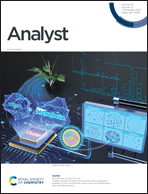A sample-to-answer DNA detection microfluidic system integrating sample pretreatment and smartphone-readable gradient plasmonic photothermal continuous-flow PCR†
Abstract
As the gold standard for nucleic acid detection, full-process polymerase chain reaction (PCR) analysis often falls into the dilemma of complex workflow, time-consuming, and high equipment costs. Therefore, we designed and optimized a DNA quantification microfluidic system by strategically integrating sample pretreatment and a smartphone-readable gradient plasmonic photothermal (GPPT) continuous-flow PCR (CF-PCR). Through preloading and sequential injection of immiscible extraction reagents, combined with magnetic bead (MB) manipulation, the microfluidic chip successfully purified and concentrated 100 μL of HBV-DNA spiked plasma into a 20-μL purified sample within 14 minutes. With a digital PCR platform, the optimized experiments showed that the DNA extraction efficiency can reach 69% at an immiscible reagent configuration ratio of 10 : 10 : 1 : 12 : 2 (sample : lysis/binding buffer : MB : silicone oil : eluent) and a flow rate of 25 μL min−1. For the first time, we used gold nanorod (AuNR)-doped PDMS to prepare a CF-PCR submodule for the amplification of a 40 μL PCR mixture. Due to the plasmonic photothermal effect of AuNRs and the gradient intensity of an expanded laser spot, the PCR thermal gradient was formed on a coin-sized area. The compact annular thermal-microfluidic layout, optimized DNA dye concentration, and chip transmittance synergistically enable a rarely reported smartphone-based fluorescence CF-PCR, greatly simplifying thermal control and detection setup. Prototype construction and validation experiments show that the microsystem can complete the sample-to-answer quantification of HBV-DNA with a dynamic linear range from 1.2 × 101 to 1.2 × 106 copies per μL in ∼37 minutes. This novel microfluidic solution effectively bridges the technical gap between the CF-PCR, sample pretreatment and result characterization, making the workflow standardized and rapid and requiring <15% of the commercial instrument cost. The simplicity, rapidity and low cost of this work make it promising for applications in decentralized laboratories and low-resource settings.



 Please wait while we load your content...
Please wait while we load your content...